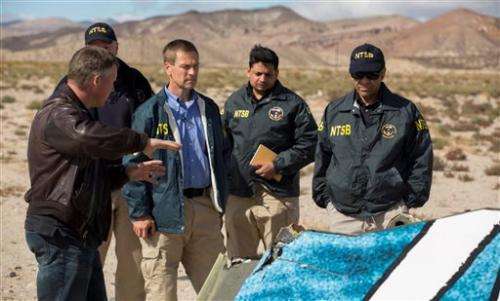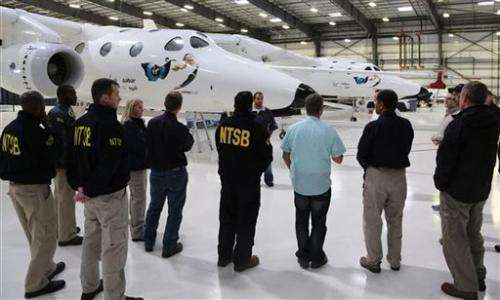A look at Virgin Galactic's feathering technology

The Virgin Galactic spaceship destroyed when it broke apart high over the Mojave Desert was designed to take tourists on a fleeting thrill ride through the lower reaches of space.
On the way back down, the tail sections of the rocket-powered ship are supposed to sweep upward to slow it for the return to earth. The "feathering" system is now being reviewed as part of the investigation into Friday's deadly accident that caused SpaceShipTwo to disintegrate, killing one pilot and badly injuring another.
Here are some answers to questions about how the system works.
WHAT IS FEATHERING?
SpaceShipTwo is designed to take two pilots and six passengers into the vacuum of space on the power of a rocket engine after being launched from a jet-powered mother ship at an altitude of about 50,000 feet. Like with any other space flight, the return trip has proven to be one of the biggest technical challenges and periods of greatest danger.
Designer Burt Rutan's inspiration for the design was the badminton shuttlecock, which relies on its aerodynamic shape to control orientation, speed and altitude.
SpaceShipTwo's feathering system is based on Rutan's designs. Its entire tail structure can rotate upward, giving the craft the ability to slow down and float like a feather as it re-enters the upper atmosphere.
HOW DOES IT WORK?
Just before SpaceShipTwo reaches its maximum altitude at the edge of space, the craft's pilots begin to prepare for descent by unlocking the tail sections. This begins a two-step process for rotating the tails upward.

With the tail sections in the raised position, the craft's fuselage moves parallel to the horizon. This configuration results in extreme drag and allows the craft to begin slowing down at a high altitude, which reduces forces on the craft.
Despite all the drag, the feathering formation is also stable—so stable that Virgin Galactic officials have said pilots can take their hands off the controls. And with the craft's low weight, re-entry temperatures remain low compared with other manned spacecraft, making heat shields or tiles unnecessary.
Once SpaceShipTwo hits about 60,000 feet, the tail sections automatically return to their original configuration and the ship glides back to earth.
WHY IS THE SYSTEM BEING REVIEWED?
Although the cause of the crash has not been determined, investigators have said the feathering system was unlocked before the craft reached an appropriate speed. The system requires a separate command to activate.
Deployment must happen at the right time, shortly before the craft reaches its maximum altitude. Missing the mark could cause problems given the speeds and structural forces being exerted when the spacecraft re-enters the atmosphere.
© 2014 The Associated Press. All rights reserved.



















